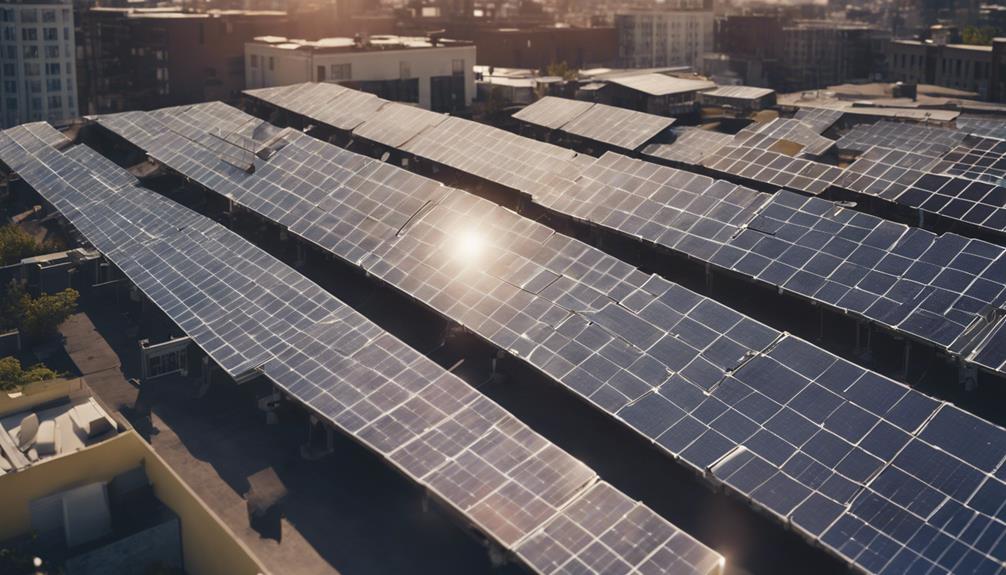As I explore ways to revolutionize urban transportation, I am keen to discover the potential of solar-powered bike lanes. These innovative lanes not only reduce our reliance on fossil fuels but also increase energy efficiency and safety. By integrating solar panels into bike lanes, cities can promote eco-friendly transportation options, reduce congestion and pollution, and transform travel experiences. While there are challenges to overcome, the benefits of solar-powered bike lanes are undeniable. As I dive deeper, I am excited to learn more about the strategies and solutions that can make this sustainable transportation solution a reality. I believe that incorporating solar post caps into these bike lanes can further enhance visibility and safety for cyclists at night. Additionally, the energy generated by the solar panels on the bike lanes can be utilized to power streetlights and other urban infrastructure, making cities more sustainable and cost-effective. By embracing these innovative technologies, we can create a greener and more efficient urban environment for all.
Key Takeaways
- Solar-powered bike lanes increase energy efficiency and safety while reducing reliance on fossil fuels, mitigating climate change impacts.
- Integrating solar power into bike lanes offers economic advantages, including reduced maintenance costs and increased property values.
- Careful planning, stakeholder coordination, and public education are crucial to overcome barriers to adoption and ensure successful implementation.
- Solar-powered bike lanes enhance safety and efficiency through illuminated markings, organized traffic flow, and reduced congestion and pollution.
- Community engagement and education are essential to foster environmental responsibility, community ownership, and participation in sustainable transportation solutions.
Solar Energy for Sustainable Cities

As I pedal through the city, I'm struck by the immense potential of solar energy to transform urban transportation and create a more sustainable future.
Solar-powered bike lanes are a game-changer, increasing energy efficiency, sustainability, and safety through illuminated markings.
By harnessing the power of the sun, we can reduce our reliance on fossil fuels and mitigate climate change impacts.
Integrating solar power into our infrastructure not only benefits the environment but also offers economic advantages.
It's time to revolutionize urban transportation and make a greener, more sustainable future a reality.
Challenges in Implementation and Maintenance

As I consider the extensive advantages of solar-powered bike lanes, I'm also aware that implementing and maintaining them comes with its own set of challenges. One major hurdle is the initial installation cost, which can be prohibitively expensive for many cities.
Another challenge is integrating the solar panels into existing bike lanes, which requires careful planning and coordination.
In addition, the durability and maintenance of the panels can be a concern, particularly in areas with harsh weather conditions. Moreover, technical issues such as battery storage and grid integration need to be addressed.
Despite these challenges, it's essential to push forward and find solutions, as the benefits of solar-powered bike lanes far outweigh the costs.
Overcoming Barriers to Adoption

Several strategies can help overcome the barriers to adopting solar-powered bike lanes, including careful planning, stakeholder coordination, and innovative solutions to technical issues.
As I explore the challenges, I realize that addressing public acceptance is vital. Educating communities about the benefits of solar-powered bike lanes can increase adoption rates.
Additionally, collaborating with local organizations and governments can help alleviate concerns about initial installation costs and maintenance. By offering incentives and subsidies, we can make solar-powered bike lanes more accessible to a wider audience.
Enhancing Safety and Efficiency

One key advantage of solar-powered bike lanes is that they can greatly enhance safety and efficiency by providing illuminated markings, reducing accidents, and promoting a more organized traffic flow.
As I've seen in successful implementations, solar panels integrated into bike lanes can increase energy efficiency while reducing our reliance on fossil fuels. This innovative approach not only benefits the environment but also improves the overall cycling experience.
By providing a well-lit and safe infrastructure, we can encourage more people to opt for eco-friendly transportation, ultimately reducing congestion and pollution in urban areas.
It's exciting to think about the potential of solar-powered bike lanes to transform the way we travel and interact with our cities. These innovative bike lanes could not only provide a sustainable means of transportation, but also contribute to reducing carbon emissions and promoting healthier living. The efficiency with sunlight could offer a practical solution to powering the lighting and safety features of these lanes, making them both environmentally friendly and cost-effective. As this technology continues to develop, it holds the promise of revolutionizing urban infrastructure and creating more sustainable and vibrant urban environments for future generations.
Community Engagement and Education

I believe that engaging with local communities and educating citizens about the benefits of solar-powered bike lanes is essential for their successful implementation and adoption. By hosting workshops, collaborating with local organizations, and leveraging social media platforms, we can raise awareness about the advantages of solar energy in urban transportation. This not only fosters environmental responsibility but also encourages community ownership and participation.
| Benefits | Impact |
|---|---|
| Increased safety | Reduced accidents and injuries |
| Enhanced sustainability | Decreased carbon footprint |
| Economic benefits | Job creation and cost savings |
Factors Affecting Solar Panel Requirements

As we've seen the importance of community engagement in promoting solar-powered bike lanes, now it's time to explore the key factors that influence the requirements of solar panels, which are essential to the success of these sustainable transportation solutions.
As I investigate the specifics, I realize that sunlight availability plays a significant role. The amount of sunlight an area receives directly impacts the number of solar panels needed.
Cost considerations, government incentives, and panel efficiency are also vital factors. Additionally, energy consumption patterns and historical weather data must be analyzed to determine the ideal number of solar panels required.
Ensuring Inclusive Solar Energy Access

As I explore the world of solar-powered bike lanes, I'm reminded that economic disparities can impede the adoption of this innovative technology.
Despite the numerous benefits of solar energy, economic disparities continue to restrict access to this sustainable power source, particularly for low-income households that need it most.
It's crucial to recognize that the initial installation costs, although decreasing, remain a significant barrier for many.
To ensure inclusive solar energy access, governments must implement policies that offer financial incentives and subsidies to low-income households. Additionally, community-based initiatives and partnerships can help bridge the gap, making solar energy a more fair and accessible option for all.
Frequently Asked Questions
Can Solar-Powered Bike Lanes Be Integrated With Public Transit Systems?
"I believe solar-powered bike lanes can seamlessly integrate with public transit systems, enhancing urban transportation's sustainability and efficiency, while promoting a greener future through innovative, eco-friendly infrastructure solutions." Additionally, solar-powered bike lanes can provide a safer and more accessible route for cyclists, reducing the reliance on cars and promoting a healthier lifestyle. With the integration of electric bikes, such as those used in ‘hairy bikers’ electric bike adventures‘, the reach and accessibility of these sustainable transportation options can be expanded even further, making it easier for commuters to choose environmentally friendly modes of travel. This combination of solar-powered infrastructure and electric bike technology has the potential to revolutionize urban transportation and significantly reduce the carbon footprint of cities.
How Do Solar Panels in Bike Lanes Impact Emergency Vehicle Access?
'Talk about a bright idea – solar panels in bike lanes But, can they hinder emergency vehicle access? Thankfully, no; clever design guarantees panels are raised or removable, allowing easy passage for emergency responders.'
Are Solar-Powered Bike Lanes Compatible With Snow Plowing Operations?
'I wonder if solar-powered bike lanes can coexist with snow plowing operations. The impact of snowplows on the panels and the lanes' design must be considered to guarantee safe and efficient snow removal.'
Can Solar Energy From Bike Lanes Power Streetlights or Buildings Nearby?
"Personally, I think solar energy harnessed from bike lanes can definitely power streetlights or nearby buildings, especially with efficient energy storage systems and smart grids that optimize energy distribution and usage."
Do Solar-Powered Bike Lanes Require Special Permits or Licenses?
"As I pedal into the future, I find that, yes, solar-powered bike lanes do require special permits or licenses, which can be a hurdle, but one that's worth clearing for a brighter, sustainable tomorrow."
How Do Solar-Powered Bike Lanes Revolutionize Urban Transportation?
Solar-powered bike lanes are spearheading the solar power in transportation revolution. These innovative lanes are not only providing a sustainable energy source but also enhancing safety for cyclists. With built-in LED lights and sensors, these lanes are transforming urban transportation by promoting eco-friendly and efficient mobility options.
How Do Solar-Powered Bike Lanes Compare to Electric Bikes in Revolutionizing Urban Transportation?
Solar-powered bike lanes have the potential to greatly impact urban transportation, especially when compared to electric bikes in cities. While electric bikes offer a convenient and eco-friendly mode of travel, solar-powered bike lanes provide a consistent and sustainable energy source for cyclists, making them a revolutionary addition to city infrastructure.
How Do Solar-Powered Bike Lanes Contribute to the Clean Transportation Revolution?
Solar-powered bike lanes are a game-changer when it comes to clean transportation. By utilizing solar power for clean transportation, these innovative lanes not only provide a safe pathway for cyclists but also generate renewable energy for street lighting and other infrastructure, contributing to the overall clean transportation revolution.
How Do Solar-Powered Bike Lanes Revolutionize Urban Transportation?
Solar-powered bike lanes are contributing to the solar power in transportation revolution by providing a sustainable and eco-friendly way for urban commuters to travel. By harnessing the power of the sun, these lanes not only support clean energy but also promote the use of bicycles as a means of transportation.
How Are Solar-Powered Bike Lanes Revolutionizing Urban Transportation?
Solar-powered bike lanes are transforming sustainable urban planning with solar energy by providing a green transportation solution. These innovative lanes harness the power of the sun to illuminate paths and increase safety for cyclists. Additionally, they promote eco-friendly commuting in urban areas, reducing the carbon footprint and promoting a greener future.
How Can Solar-Powered Bike Lanes Revolutionize Urban Transportation?
Sustainable urban planning with solar energy and bike lanes has the potential to revolutionize urban transportation. By integrating solar-powered bike lanes into city infrastructure, we can reduce carbon emissions and promote alternative modes of transportation. This innovative approach can create a more eco-friendly and efficient urban environment.
How Are Solar-Powered Bike Lanes Revolutionizing Urban Transportation in the US?
Solar-powered bike lanes are revolutionizing urban transportation in the US by integrating sustainable energy solutions into everyday city life. The implementation of solar energy usage in US bike lanes not only promotes eco-friendly commuting but also reduces dependency on fossil fuels, making cities more efficient and environmentally friendly.
Conclusion
As I pedal into the future, I envision vibrant streets where solar-powered bike lanes shimmer with sustainability.
By sparking systemic change, we can swap smog for solar, silence for serenity, and scarcity for abundance.
Together, let's ride the wave of innovation, illuminating a path towards a brighter, cleaner, and more resilient urban landscape.










